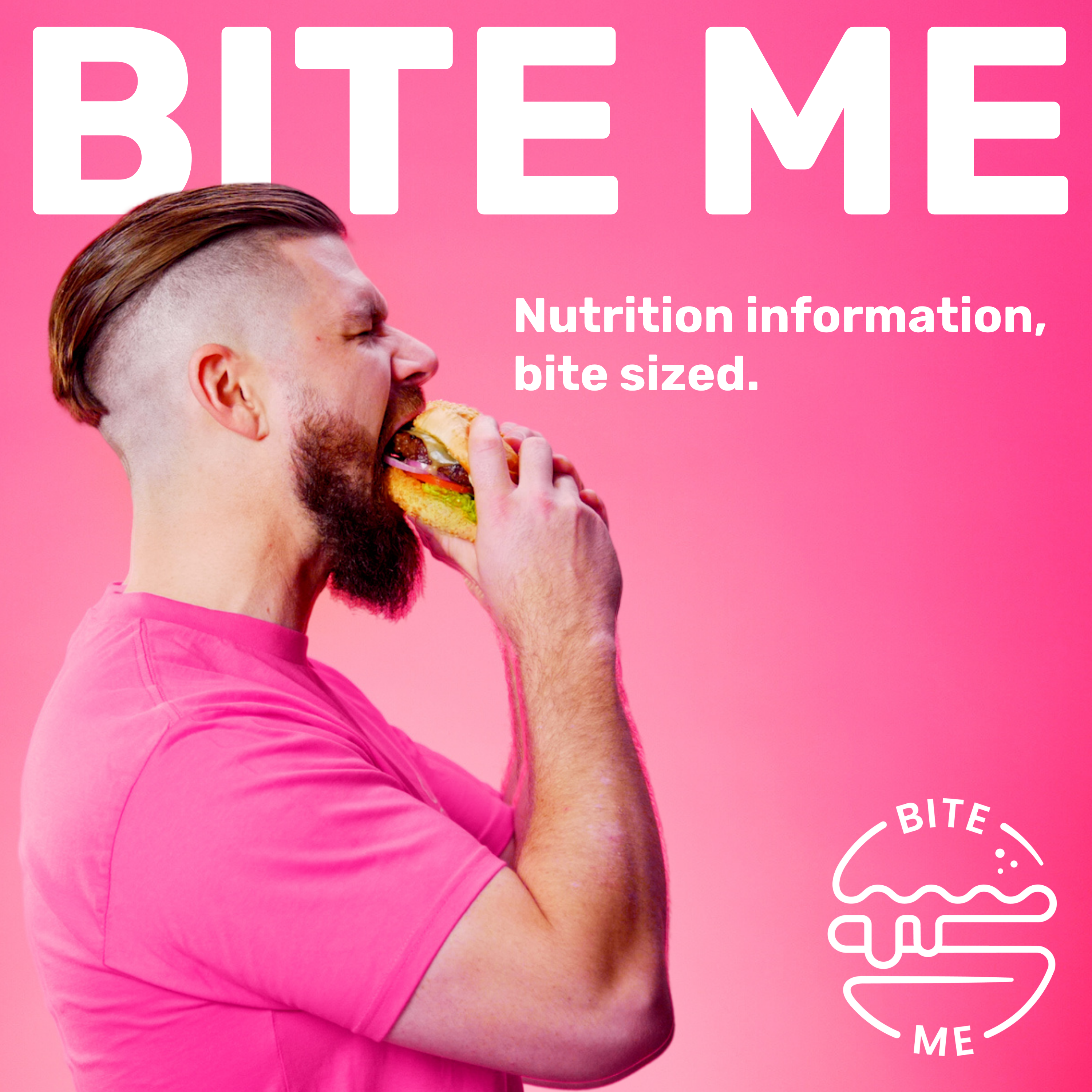FOD-WHATS?!
Let’s talk FODMAPs!
It’s fun to say, but what are they? Where are they found? Do you need to worry about them? Should I try the low FODMAP diet?
Stop asking questions and listen to the episode. It will (probably) contain all the answers you seek.
Transcript
Welcome back to the Bite Me Nutrition podcast.
Today we're going to be going through FODMAPs, what they are, what that funny word means, where you might find them, why they may or may not be relevant to you. And then, of course, we can't really talk about FODMAPs without also quickly going through the low FODMAP diet.
So we'll finish by going through that, what those different stages are, to give you a bit of an overview. And so hopefully look, for some of you this podcast is going to be super irrelevant because you're not going to be sensitive to any flat maps and that's awesome. You can maybe, I don't know, listen to this because it's still going to be interesting for others, I don't know, you might have a little bit of a light bulb moment and go, this is something I've never considered before. Maybe I need to reach out to a professional who can help me chat through this a bit further or take this a little bit further.
So today will be a brief overview of FODMAPs and their potential role in IBS and bloating, as well as the low FODMAP diet, if that sounds like you, please stick around.
So basically the term FODMAP is an acronym. It stands for fermentable, oligosaccharides, disaccharides, monosaccharides and Polyols. So super easy to remember all of that, I'm sure. But basically what they are is these are different types or different families of short chain carbohydrates. So just what that means is they're small fibers that our body can, our gut bacteria can ferment.
Happy days. There are six different types. We've got fructans, galacto oligosaccharides or gauss excess fructose, lactose, which you're probably familiar with, manatoll and sorbitol. And what you'll find is different foods contain different FODMAPs. Some foods contain a couple of fod maps in one, others contain no FODMAPs or very, very low levels of FODMAPs and would be considered what we would phrase as low FODMAP. However, things like garlic and onion are high specifically in the FODMAP fructans. Milk is high, specifically in lactose. What's another example? So almonds are specifically high in galactans or galacto oligosaccharides. So it's not really about going low FODMAP forever and removing all of these FODMAPs because generally if someone is sensitive to FODMAPs at all, because a lot of people aren't, but if you are, it's very unlikely that you're going to be sensitive to all six forever. What typically the case is you are sensitive or intolerant of one, two, potentially three. But by going through the low FODMAP diet and that whole process which will take you through in a moment, you can identify which of the six FODMAPs are specifically problematic. And then look at adjusting your intake of just foods high in that FODMAP rather than blanket removing a whole heap of other very, very healthy foodsthat you otherwise don't need to remove.
So, for example, if you are sensitive to fructans, you may need to moderate your garlic and onion intake. But that doesn't mean you need to moderate your avocado intake, because avocado is actually high in sorbitol. And if you're not sensitive to sorbitol, it would be such a shame for you to remove something as nutritious or nutrient dense as avocado from your diet, unnecessarily. So that's why it's really important that we don't just stop it going, quote on quote, low FODMAP. There's a lot more to it than that. But the reason we talk about going low FODMAP at all when we're talking about specifically IBS related symptoms and bloating, it's, there's kind of a couple of different mechanisms by which that might happen.
The first is FODMAPs can draw water into the small intestine throughout their journey through the gut, and that obviously causes the small intestines as well, which is uncomfortable and can cause a few other problems. Then as the FODMAPs travel through and reach your large intestine in some individuals, they can be over fermented by their gut bacteria. This causes rather than just kind of a normal natural level of gas production, we get an excessive amount of gas production, which can significantly increase the amount of bloating. And distension can draw more water into the large intestine as well. And this water retention plus the gas production can also then begin to trigger or exacerbate something called visceral hypersensitivity, which is when the very intricate and delicate web of nerves that surrounds your gut organs can essentially over fire and get over triggered.
There's a word that I can't find anywhere I'm going to go with trigger. And so that can then also have an impact on the gut brain axis that can it can be a bit of a snowball, be of a vicious cycle. Anyway, this is not a podcast on IBS or bloating. That would actually be a good idea. I should do that. I'll put that on the list. But for now, that's kind of the very, very broad view of why we talk about FODMAPs when it comes to bloating and IBS.
Now, there are lots of lots of other lifestyle and environmental and other dietary factors that may be playing a role in bloating or IBS. If that is something you suffer with, please do not immediately diagnose yourself with a FODMAP intolerance and put yourself on the low FODMAP diet just because you're bloated, right? Don't do it. You wouldn't do that. I'm sure I can trust you, but just don't do it. If that is something you struggling with, the first thing you should do is see your GP. They'll ask you a few questions, mostly to rule out some potentially scary stuff. I don't want to panic you. It's just good to rule that stuff out.And then if they do just diagnose you with sort of general IBS, the next thing I would be doing is seeing a dietitian who can dive into some of those other environmental factors, dietary factors, and then potentially look to see if the low FODMAP diet is suitable for you.
So excellent. Segue it's like I planned this into what the low FODMAP diet is. It's a three stage diet. Like I said, it's generally something that we would implement after we've checked off a few other things to make sure that there's not other factors contributing to the bloating and the IBS, as the name suggests, it's low in FODMAPs. So those foods I mentioned before, garlic, onion, milk, avocado, like, it's a much, much bigger list, but it's a diet that is low in those foods and it's designed to help you eventually identify which specific FODMAPs you may be sensitive to. Right?
So like I said, there's three stages, and the first stage is probably the hardest, and that is the low FODMAP phase, where for six to eight weeks, we remove all high FODMAP foods, we replace them with low FODMAP foods, and the goal is to essentially find a reduction in all symptoms so we can find this little bit of a baseline. Right? It's important that we do this for the six to eight weeks because even after you've removed some of the trigger foods, there can still be some longer lasting visceral hypersensitivity and a few other things. So if we can give it that six to eight weeks, it essentially really lets the gut calm down. It's really important to note at this point that the low FODMAP diet should not be a long term approach virtually ever. I know it can be tricky, especially if you're someone who's been suffering with symptoms and the low FODMAP portion of this diet has given you relief. You kind of just want to stay there forever because it's comfortable. But it's really important we don't dothat for a couple of different reasons.
The first is the low FODMAP diet is generally a little bit deficient in fiber. You're at risk of being low in calcium, B, vitamins, and a few other bits and pieces because of just the unfortunately necessary restrictive nature of the diet. It also significantly reduces your dietary diversity and just your dietary fiber diversity, which is going to have an impact on your long term gut health, right? So important, again, not to just stay in the low FODMAP phase forever. Socially it's going to have a big impact because it does limit what you're eating. So again, it's not something you want to do for longer than you have to because ultimately, fod maps the actual little fiber types, if you are not overly sensitive to them, they are really healthy. They are one of your gut bacteria's favoUrite food.So like I said previously, if you're sensitive to one of those FODMAPs, figuring out what that is so you can get the other five fod maps in your foods, containing FODMAPs in is really important for long term health. So I think I've lent on that point hard enough. Don't stay low FODMAP forever.
The second phase is called the challenge phase. And this is when we start to reintroduce specific foods that are high in specific FODMAPs. Like I said, there's a few foods that contain kind of two or more FODMAPs. They're not helpful in this stage because if you introduce something that's high in, say, fructose and fructose and you get some symptoms, we don't know which of the two FODMAPs triggered that. So we use sort of specific foods high in specific FODMAPs and in specific amounts. So specific serving sizes, becausethat's a good example. So, for example, 60 to 80 miles of milk would be considered like moderate FODMAP, whereas 125 to 250 mils of milk is moving into higher FODMAP, right? So we can't just say add milk. We would be more specific with our serving sizes. We'd do that for a few days. We'd probably gradually build the dose or the serving size up over two to three days, when we would wait to see, usually via a well kept food diary, have you experienced symptoms, if not giving it seven to ten days in between each challenge. And then you would challenge again with the next FODMAP family, and you would move through the challenge phase like that. At the end of the challenge phase, the goal will have been you've identified which of the FODMAPs is the problematic one, which one you are sensitive to. And this is where we move into the third phase, which is personalization.
The good news is most people can tolerate some level of the FODMAP that they are sensitive to. So once you've identified the FODMAP or FODMAPs that you are sensitive to, it's not about eliminating them all entirely forever. The personalisation phase is really about figuring out what your individual threshold or dose is. So you might find that if you are sensitive to lactose, a serve of Greek yogurt in the morning and a little bit of milk in your coffee caffeine is another tricky thing, but we'll talk about in another podcast, you might find that those two serves that's not too much lactose, even if you are sensitive to lactose. But if you then have some cheese in your sandwich at lunch and some ice cream for dessert, that may tip you over your threshold. And so the personalization phase is about finding out what your threshold is so we can work within that. And again, the goal being to include as much variety and as much foods in our diet as we can whilst still managing our symptoms. Longer term, it is important to kind of retest your sensitivity to these foods because your sensitivity does change. So making sure that you don't just restrict that FODMAP forever or stick to one serve a day, you may potentially find that you can include more as you move forward.
Last thing I would just say around FODMAP, something I always like to mention as well, is if it turns out that you are sensitive to XYZ, of the FODMAPs. The symptoms that you experience when you eat that FODMAP aren't in and of themselves dangerous. It's not an inflammatory response, it's not an allergic response. Which means that if after eating too much ice cream that crosses your threshold and you feel terrible, no physical damage is done. So you can choose to roll those dice or choose to accept the consequences of your actions. Sometimes if you are in a scenario where there's that incredible gelato that you've been waiting years to try and you just want to go for it, that is your choice as an adult. But really, the whole point of reaching that end stage of the FODMAP diet isn't to completely eliminate those foods, it's to give you that clarity around what your specific triggers are and how you can work through them. So last thing I will say, I swear, if I find out someone's just throwing themselves on the low FODMAP diet without because it's really frustrating when I have a new client who comes to me who says they've done the low FODMAP diet before but hasn't done it properly, and I don't blame their role for that. It's a very hard diet. But what it means is those six to eight to ten to twelve weeks that they spent doing that lowFODMAP diet was kind of a waste of time. So if you're going to do it, please do it with the help of a professional. Please use the FODMAP at the Monash FODMAP app. It is incredible. Not sponsored would pay ten times what I paid for it happily. It's incredible.
But if this is something that has piqued your interest in something you think might be relevant to you, please chat to your GP or reach out to a dietician who can help, or send me a message on all of the different places. All roads lead to Rome. And if you've enjoyed this podcast, as always, please feel to it's like 12:00 that night. So I apologize, but please feel free to like subscribe, et cetera, et cetera, and love you forever. Bye.


